Meteorological disasters have occurred frequently in some areas in recent years, with wide-ranging impacts, seriously affecting the growth and development of Tea plants, leading to a decrease in tea yield and quality.

Results and Analysis
1. Early Spring Frost
Early spring frost is one of the main meteorological disasters that affect the growth of tea plants. A daily minimum temperature ≤ 4°C in March-April is used as an indicator of early spring frost. The results are shown in Figure 1. The cumulative number of days with early spring frost in Wuyuan County shows an overall decreasing trend. The average temperature in March-April and the extreme minimum temperature in March show a fluctuating upward trend, indicating that over the past 13 years, the average temperature in March-April has generally increased, and the frequency of extreme low temperatures and frosts has decreased, resulting in a lower frequency of early spring frost disasters in tea gardens.
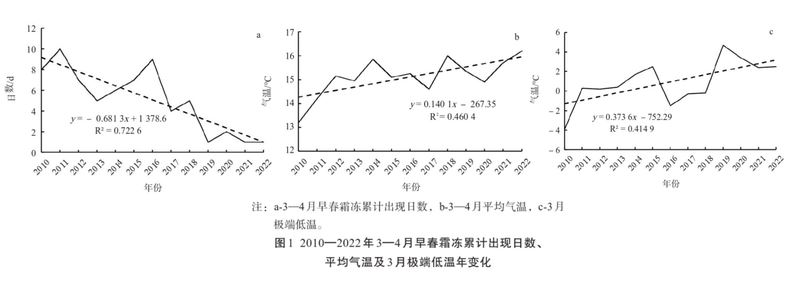
2. Summer Drought
Summer heat and drought, along with insufficient rainfall, can easily cause the buds and leaves of tea plants to wilt and become scorched, leading to a decrease in Autumn Tea production and, in severe cases, even the death of tea plants. The results show that the cumulative number of days with summer heat stress in Wuyuan County shows an overall increasing trend. The average temperature and extreme maximum temperature in July-August fluctuate but show a slight overall increase, consistent with the increasing trend in the cumulative number of days with summer heat stress.

3. Winter Freeze Damage
After being subjected to winter freeze damage, the edges of the leaves and buds of tea plants turn dark brown, and the leaves lose water, curl up or fall off, which affects the picking of Spring Tea in the following year. A daily minimum temperature ≤ -5°C from December of the previous year to February of the current year is used as an indicator of winter freeze damage. The results show that the cumulative number of days with winter freeze damage in Wuyuan County shows a slightly increasing trend. From 2010 to 2025, the cumulative number of days with early spring frost in Wuyuan tea showed a decreasing trend. Summer heat stress and winter freeze damage are sporadic, with fluctuations and slight overall increases in winter average temperatures and extreme minimum temperatures.

The correlation analysis results show that early spring frost has a significant impact on the development of tea plants. The number of days from bud opening to leaf unfolding and the number of days from bud opening to peak leaf unfolding are positively correlated with the number of days with early spring frost, indicating that the more days of early spring frost, the later the development process of tea plants; summer heat stress has a certain impact on the development of tea plants; winter freeze damage does not have an obvious impact on the development of tea plants.
Disaster Countermeasures
I
Summer Heat Stress
The defense against summer heat stress can be achieved through reasonable selection of varieties and cultivation techniques such as shading, irrigation, and mulching.
1. Shading Method
The shading method mainly involves setting up a canopy at a height of 1.8-2.0 m above the tea garden and covering it with shade nets or directly covering the tea plant canopy with shade nets, securing them around the edges to reduce direct sunlight.
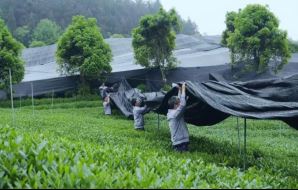
2. Irrigation Method
The irrigation method requires the reasonable selection of irrigation methods. Sprinkling is suitable during high temperatures, while drip irrigation is suitable during drought. Irrigation should ideally be carried out in the morning or evening, avoiding winds stronger than level 3.
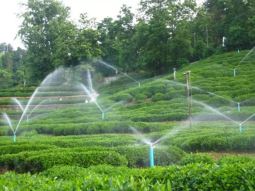
3. Mulching Method
The mulching method mainly involves laying straw or other materials between rows of tea plants, usually with a thickness of about 10 cm.
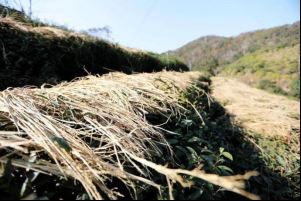
If tea plants have suffered from summer heat stress, remedial measures such as pruning dead branches can be taken. If the lack of plants due to the death of seedlings causes gaps in rows, timely replanting should be done in October-November or February-March of the following year.
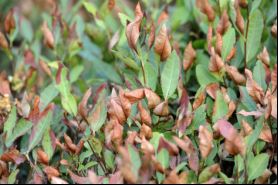
II
Cold (Freeze) Damage to Tea Plants
Cold (freeze) damage to tea plants typically occurs during winter or early spring, such as winter freeze damage and early spring frost. Before cold damage occurs, defenses can be implemented by selecting cold-resistant, high-yielding tea plant varieties, applying basal fertilizers reasonably, supplementing with potassium fertilizers, spraying foliar fertilizers, or using plant growth regulators.
If tea plants suffer from cold (freeze) damage, post-disaster remedial measures such as tea garden pruning can be taken to minimize losses, pruning away partially damaged branches due to freeze, and replanting where plants are missing.
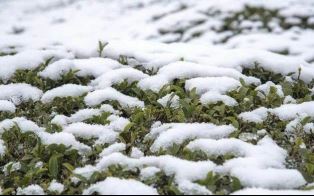
This study clarifies the relationship between major meteorological disasters and the development of tea plants and proposes countermeasures, providing a basis for future professional meteorological services for tea production.